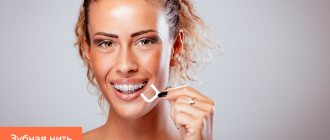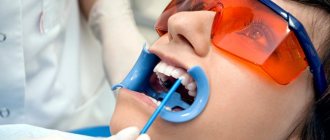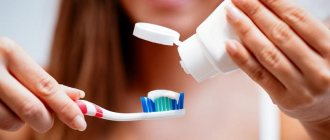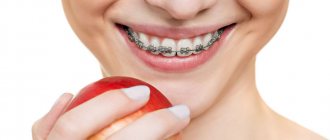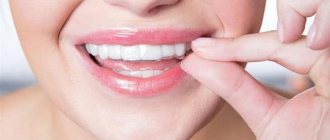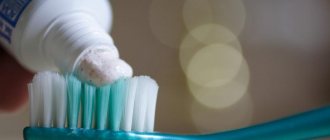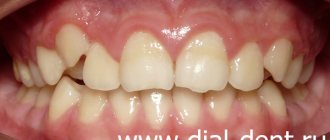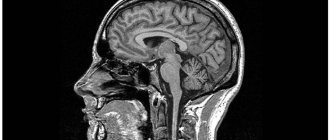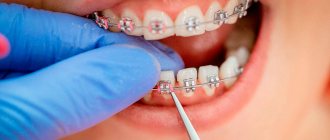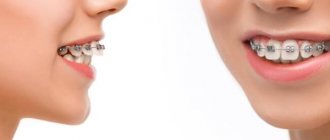A luxurious snow-white smile is a permanent trend of our time. However, not everyone is lucky enough to have naturally straight and healthy teeth. Ashamed of their smile, many people endure awkwardness for years, get used to expressing emotions sparingly and live in isolation. But in vain! Modern brace systems allow you to perfectly and discreetly straighten your teeth, and some models of braces can even become a real decoration for your smile during the treatment period.
If you are no longer ready to put up with crooked teeth and decide to act, an experienced orthodontist will assess the severity of the defects and propose an optimal correction plan. An important factor when choosing a bracket system is the aesthetic appearance of the finished structure and its cost. Knowing the features and nuances of various braces, you will make the right choice and get the desired result.
Which bracket system to choose and what results to expect – read our article.
What are braces and how do they work?
Orthodontic braces, also known as braces, are permanent structures designed to correct the bite and eliminate defects in the dentition. Their effect is based on the force of resistance, when special bracket system plates are fixed with locks on the outer or inner surface of the teeth, and the metal arch connecting them steadily returns to the specified position, slowly but surely aligning the teeth in a row.
The effect of any braces on the teeth is a small but constant pressure, and during the therapy the orthodontist will loosen or tighten them more, will use arches of different shapes and thicknesses - this will allow you to change the degree of pressure and ultimately achieve the correct position of the teeth. Under the influence of braces, not only the teeth, but also the surrounding bone tissue experiences pressure; braces trigger the process of its remodeling. This happens very slowly, which is why in some cases braces must be worn for up to three years to achieve optimal results.
All bracket systems are classified as follows:
- by material of manufacture: polymer, metal, plastic, combined or sapphire;
- according to the method of connecting the plates to the arc: ligature (classical) and non-ligature (self-regulating);
- according to the place of attachment: vestibular (external), lingual (internal).
Prices for braces for adults
By cost, braces can be ranked from the most affordable to the most expensive as follows: • Metal ligature • Metal non-ligature • Aesthetic ligature • Aesthetic non-ligature • Lingual
Orthodontists like to say this: a modern person should be embarrassed by crooked teeth, and not by braces on them. Braces only at first glance seem like something strange, scary and inconvenient. In fact, both the patient and his environment get used to these locks on the teeth within 1-2 months. But the first results are visible already at the first activation, and with the end of treatment comes confidence in yourself, in your smile and your health. The day of braces removal is a real holiday for any patient. Treat yourself to this celebration with a beautiful smile!
Vestibular and lingual – which is better?
First, let's compare braces according to where they are attached to the teeth. Each orthodontic design has its own indications, advantages and disadvantages. And despite the fact that any braces are created to solve the main problem - correcting the bite, it is worth carefully considering the options in order to choose the best one.
Vestibular braces - a familiar classic
Vestibular braces are fixed on the front surface of the teeth and are considered the most popular in modern orthodontics. Such designs do not lead to impaired diction and are easy to maintain. The duration of therapy using the vestibular system depends on the severity of the defects. Since the external brace system is very noticeable on the teeth, the choice of materials for its manufacture must be approached very responsibly:
- metal is a reliable and at the same time very noticeable material on the teeth; many patients note its unaesthetic appearance;
- plastic is a more fragile but aesthetic material, the color of which can be selected in accordance with the natural color of the enamel, has a low cost and is often used in the manufacture of budget braces for the correction of minor defects in children and adults;
- ceramics are a more expensive alternative to plastic; ceramic structures are aesthetically pleasing and hypoallergenic;
- sapphire is the most durable, aesthetic and expensive material; sapphire braces are transparent and almost invisible on the teeth.
Some patients say the main disadvantage of vestibular braces is the inability to completely close the mouth after installation. It is worth noting that such an effect is indeed possible in case of serious bite pathologies or if the system itself is selected incorrectly.
Lingual braces are the second most popular
At one time, lingual braces replaced vestibular braces; they are fixed on the inner surface of the teeth; for their installation, a special base is made that replicates the anatomical structure of the patient’s teeth. Lingual systems are more expensive than classic ones and more difficult to manufacture, but it was their appearance that eliminated the main problem of conventional vestibular systems, because unlike them, lingual braces became almost invisible.
In recent years, some types of braces, including lingual ones, have seriously improved - they have become thinner
,
light
and hypoallergenic.
3 main advantages of lingual systems:
- They are not noticeable. And this is really a big plus of lingual structures, because in order to notice them, a person must either look closely at your jaw, or simply know that the braces are installed from the inside and specifically pay attention to this.
- When creating lingual braces, 3D modeling technology is used. This means that the predicted result of therapy can be seen even before it begins.
- Throughout the entire treatment period, the orthodontist, together with the patient, can make adjustments to the design. Classic braces do not offer this possibility.
5 main disadvantages of lingual braces:
- Therapy with lingual braces is quite painful, even compared to classic ones.
- When correcting an overbite with lingual braces, diction is seriously affected. Since the system is fixed from the inside, from the side of the tongue, it becomes very difficult to pronounce familiar words. The so-called logoneurosis may even develop, when the patient loses patience and becomes very nervous due to the fact that the usual sound pronunciation becomes inaccessible to him.
- Parts of lingual braces can injure the tongue, especially at the initial stage of treatment.
- Therapy using internal braces lasts longer than with vestibular braces.
- There are restrictions for adult patients in certain types of intimacy. As we mentioned above, lingual braces can injure the patient’s tongue, but this warning also applies to his sexual partner - any sensitive mucous membrane is at risk. Doctors do not always warn about this disadvantage of lingual braces, but this does not eliminate the problem itself.
As you can see, despite a number of advantages and high cost, lingual braces are not indicated for all patients and have a number of features. Wear invisible braces, but put up with the inconvenience or choose a vestibular system - it’s up to you.
Oral irritation is a problem that should not be tolerated
The mouth has difficulty adjusting to braces, not only in terms of articulation, but also in terms of freedom of movement. Any staples take up space and don't allow your lips to fit as they are used to. In addition, the movement of the cheeks is slightly limited. If you feel discomfort in your cheeks or perhaps have ulcers or scratches on them, make an appointment with your dentist immediately. Most likely, the cheek is injured by the protruding arch of the bracket. The doctor should trim it or give you special wax, with which you can make the edge of the arch smooth and safe. If braces severely irritate the mucous membranes of the lips, you should consider changing them to lingual ones. They do not come into contact with the mucous membrane at all and do not cause irritation. However, before the change, you should definitely discuss your concerns with your doctor; perhaps he will recommend being patient a little longer until you adapt.
Painful sensations are everything. Ideally, any discomfort should disappear within 7-10 days. This time is enough for you to fully adapt to the new sensations in your mouth. After this, all that remains is to get used to the features of the new oral hygiene.
Ligature and non-ligature - what's the difference?
Do you remember that the main elements of the design of braces are plates (overlays on the teeth with locks) and an arch? Let us now compare braces according to the method of connecting the plates to the arch - they are ligature and non-ligature.
Ligature
It is ligature braces that are considered classic in orthodontics; their use is an old and proven method of occlusion correction. Due to their high efficiency, ligature systems are still relevant today. With the help of ligatures, you can correct the most complex pathologies, including mesial, distal, open or deep bites.
Ligatures are small wires with which a power arc is fixed to each clasp on the surface of the tooth. Typically, ligatures are used at the initial stage of therapy, and later, after slightly weakening the structure, they are replaced with special rubber bands. \
Advantages of ligature braces:
- effective correction of any malocclusion;
- the ability to use colored rubber pads and create stylish individual brace systems;
- low cost.
Flaws:
- massive structure;
- risk of damage to the oral mucosa;
- long period of patient adaptation to the design;
- long period of treatment;
- The ligature makes the braces very noticeable.
Unligated
In the course of work to improve orthodontic treatment methods, non-ligature (self-regulating) braces were developed - modern designs that are distinguished by fixing the arch to the clasps. Thanks to a special fixation system, the load on the metal arch is reduced and the teeth move with less force. The advantages of such a system allow patients to endure the entire period of therapy much more comfortably.
Ligature-free systems have a number of advantages:
- a fairly simple process of installation and subsequent correction;
- shortened therapy period;
- gentle effect on the dental system;
- fast adaptation;
- minimal risk of complications;
- basic hygiene care;
- Periodontal diseases are not a contraindication for the installation of such a system;
- smaller size compared to ligatures;
- the designs are aesthetic and almost invisible on the teeth.
And some disadvantages:
- they are not used to correct complex malocclusions;
- have a high cost.
Menu during orthodontic treatment
After reading the list of restrictions above, you are no doubt wondering, “So what can braces bearers eat?” In fact, the list of dishes is very large, you just need to show a little imagination and follow the recommendations above. I will list only a small part of the recommended dishes so that you can get new ideas for culinary experiments during orthodontic treatment.
- Pasta, spaghetti, ravioli and so on . With cheese, various sauces and other additives there is a huge scope for creativity.
- Mashed potatoes or soft baked potatoes
- Many rice dishes with vegetables or seafood
- Various types of cutlets and dishes using minced meat
- Dumplings and dumplings
- All types of cereals
- Pies and similar baked goods (without a hard crust) with almost any variety of fillings, except nut
- Various seafood dishes (not hard)
- Various types of cheeses
- Dishes made from jelly or creams
- Smoothies and milkshakes
- Yogurts and cottage cheese with various additives
- Bananas, grapes, melons, watermelons, kiwis, strawberries and other soft fruits and berries
The above dishes are especially suitable for the beginning of treatment (especially in the first couple of weeks after bonding), when the teeth may become sore when biting on them. In the future, you can add more solid products from the second list (necessarily, cutting into small pieces). So, the menu of brace bearers cannot be called a diet. In fact, this is a complete diet, with some features and restrictions on the hardness and texture of food.
Which systems are better - with or without a ligature?
There is no clear answer to this question. From an aesthetic point of view, the best ones are those without ligature. For example, the H4 self-adjusting bracket system (OC Orthodontics) is considered one of the most aesthetic, and due to its variability and low profile, also the most effective.
It is important to understand that the main task of any brace system is to straighten the dentition and correct the bite, therefore, to correct uncomplicated anomalies, a system without a ligature is suitable, but to eliminate serious defects you will have to choose a traditional ligature design.
Only a competent orthodontist can choose the ideal braces for a patient, taking into account his individual dental characteristics, age and lifestyle.
Dietary rules: what can you eat with braces, but be careful?
Aching pain, and with it pain when chewing, goes away 5–7 days after activation of the orthodontic arch. At this stage, you can return to your normal diet, with some exceptions. You will have to avoid extremely hard foods that need to be chewed:
- from dryings and crackers;
- from nuts;
- from caramels and grilled sweets;
- from bars and chocolate with whole kernels or large pieces of nuts, etc.
When chewing hard food, even metal braces can come off, and fragile ceramic and sapphire clasps simply crack, unable to withstand the load. For this reason, hard fruits and vegetables (apples, pears, carrots) should be cut into thin slices before consumption.
Can I eat meat with braces?
You can, but only chops, kebabs, goulash, etc. must be cut into small pieces. After all, if even one brace is damaged, the integrity of the system will be compromised. During the time it takes to replace it, the correction process will stop, and you will have to wear braces longer.
Is it possible to eat ice cream with braces?
Only in a melted form! It is necessary to monitor the temperature of food. Scorching hot and excessively cold foods and drinks are generally not good for your teeth. You should not alternate hot and cold dishes during one meal. Even if the temperature difference does not harm the braces, the teeth may react to it - for example, with cracks in the enamel. In this case, caries cannot be avoided.
What material for braces should I choose?
Modern braces systems can be not just functional, they can be aesthetic, stylish, bright or transparent. This is possible thanks to the use of materials with different properties: plastic, ceramics, sapphire, simple or precious metal
. The properties of the listed materials are different; the choice of a specific one depends on the age of the patient, his preferences regarding aesthetics and structural strength, as well as financial possibilities.
| ceramics | metal | sapphire |
If you need a quick and inexpensive correction, you can opt for a metal structure; if long-term correction is expected, and the patient’s lifestyle requires publicity, it is worth considering ceramic or sapphire braces.
Are your braces rubbing? Orthodontic wax will help.
If any element of the braces system rubs on you, seal it with orthodontic wax . Usually it is given by the orthodontist after fixing the braces. In addition, you can use regular dental wax in red strips; it is not so flexible, so it must be preheated in hot water. From wax of any type, after heating it, you need to make a ball the size of a match head to a pea and attach it to the dried surface of a bracket, hook or other element of the bracket system.
Method of applying wax to brackets.
How long does it take to install braces?
The process of manufacturing and installing braces usually takes about a week and includes the following steps:
- drawing up a treatment plan: for a more accurate assessment of the patient’s dental system, the doctor does a computed tomography scan, prepares impressions of the jaw and, together with the patient, selects the optimal type of brace system.
- Complete sanitation of the oral cavity: at the initial stage it is necessary to remove carious lesions and eliminate inflammation. If the doctor understands that some teeth will interfere with the necessary displacement of the dentition, they are removed.
- Manufacturing of braces: at this stage, laboratory specialists select template designs or manufacture individual bracket systems.
- Installation: braces are fixed on the surface of the teeth using a special fluoride-containing glue and adjusted to all parameters.
Of course, it will take a week to get used to braces. After installation, the doctor will tell you in detail how to properly care for them, what food you will have to give up during the treatment period, so that the tooth enamel under the braces does not break down and lose its natural color.
If you decide to install classic ligature braces, be prepared to visit the orthodontist approximately once a month, during these visits the doctor will manually change the position of the metal arch.
Indications for replacement
The gradual restoration of shape leads to a weakening of the pressure exerted on the maxillary arch. In the case of a planned replacement, the procedure is designed to maintain directional traction, under the influence of which the problematic units continue to move into their natural anatomical position. In some brace designs, the wire tension is changed using a screw element, but each arch has a limit, which is not always enough to complete the correction cycle.
In situations where replacement is caused by the occurrence of mechanical defects that preclude the possibility of further operation of the structure, it is impossible to postpone a visit to the doctor until the next scheduled date - otherwise the entire correction cycle will have to start over again. Such cases are extremely rare - today high-strength materials are used to make braces, the likelihood of breakage of which is minimized.
At what age can you get braces?
Modern orthodontics allows you to solve the problem of crooked teeth and correct your bite at almost any age. It is most advisable to do this in young years, even before the final ossification of the jaws; the optimal time to begin bite correction in children is from 8 to 14 years. However, there are situations when correction is necessary for the patient in adulthood. Adults often seek correction of a bite that has been altered by the growth of wisdom teeth and subsequent displacement of adjacent teeth. Often the need for bite correction occurs after the removal of unhealthy teeth. The use of braces in such cases is the best way to eliminate defects.
What facial changes will occur after the bite is corrected?
After full or partial compensation of jaw anomalies, the face becomes proportional and symmetrical. However, some patients find these changes too pronounced. Transformations concern not only the oval of the face. They also affect the cheeks, cheekbones, nose, lips and chin. Let's consider all cases in more detail.
How do braces change a person's face?
- 1. Cheeks
. Before installing braces, it may be necessary to remove “eights” (“wisdom teeth”). In this regard, even before fixing the structure, it will be noticeable that instead of plump cheeks, sunken cheeks “appeared”. Also, when wearing braces, difficulties arise with chewing solid food. Dietary restrictions also affect cheek swelling. Typically, the slight hollowing effect persists even after the braces are removed. Almost all patients are satisfied with this effect. - 2. Cheekbones
. The muscle load is redistributed, facial expressions change, the cheeks become somewhat sunken, and therefore the cheekbone line becomes more pronounced. After correcting the abnormality, the muscles responsible for closing the lips face less stress. - 3. Nose
. When a patient wears external braces on the upper jaw, his nose becomes somewhat upturned. This effect gives the profile a special charm. However, it can persist even after the structure is removed. - 4. Lips
. While wearing braces, slight swelling of the lips may appear. But the effect disappears after removing the braces. - 5. Oval face
. When the upper jaw no longer protrudes, the face becomes longer and more oval. If before orthodontic treatment the lower jaw fell forward, then after removing the braces the face will appear smaller and rounder. This straightens the contour. - 6. Chin
. The shape of the chin may also change. If it has been smoothed, it may move forward, causing the profile to become smoother. If before installing the braces it seemed that the lower jaw was too massive, then after correcting this defect the chin will move back.
In order to better examine the described changes, patients take before and after photos. Thanks to a comparative analysis, it is easier to notice all the facial transformations and evaluate how much you like them.
They say wearing braces is painful...
Indeed, braces therapy very often causes discomfort, and reviews from patients who have gone through this procedure indicate that there is little pleasant about it. This occurs due to the pressure of braces on the teeth. If the patient has a low pain threshold, the orthodontist will not tighten the system too tightly and will prescribe painkillers for the first time. If, a week after installing braces, the pain intensifies and the temperature rises, you should immediately consult a doctor to find out the reasons.
In the first weeks after braces are installed, the patient may experience significant discomfort and pain throughout the jaw. This reaction is due to the gradual movement of the teeth into the desired position and is considered normal - you will have to be patient.
Immediately after installing braces, parts of the system itself can injure the mucous membrane and tongue; this problem can be solved by using special wax as prescribed by a doctor. Gradually you will get used to it and stop feeling discomfort, and after a while you will get beautiful, straight teeth and the much-desired snow-white smile!
Chronicles of a brace bearer: How to live with braces and not climb the wall out of despair
Let's continue the topic started in the last post and return to the original situation - imagine for a moment that you have just left the orthodontist, sparkling with your teeth and your shiny new accessories on them. But before you rush home, pester your family with questions - “Do I look okay with them? Are you sure it’s normal?” I should drop by somewhere and buy something. Yes, yes, my dears, you definitely won’t be limited to just spending money on installing braces.
What does a new brace bearer need to buy? There is an orthodontic set from the PresiDENT brand. If my memory serves me correctly, it includes a special toothbrush, dental floss, small brushes, a tuft brush and orthodontic wax. But finding and buying this very set is not an easy task, I warn you right away. In Astana, where, in theory, pharmacies are a dime a dozen and they are at every turn, it is difficult to find a set of braces. I bought it at the Khan Shatyr pharmacy, where I advise you to look first.
I recommend taking a closer look at the orthodontic set, because it is not bad and is perfect for a beginner brace wearer who is embarrassed and doesn’t know how to live with pieces of iron in his mouth now. In such a situation, there is absolutely no time to search for and select dental items, but you can buy a set, drag it home and calmly move on to studying your reflection in the mirror. But if you were unable to find a set on sale, you can assemble it yourself. Take, for example, a special toothbrush. They are not sold separately anywhere, only as part of the above-mentioned set, but this problem can be solved by taking a very ordinary toothbrush and cutting the bristles in the middle with scissors to form such a longitudinal pit. You can understand how all this should roughly look by studying this picture:
There is no need to buy dental floss if you are not used to using it, but dental brushes will come in handy. But even they are not the primary and most important item for a brace bearer, but orthodontic wax. You can and even need to ask your orthodontist for this wax after installing braces. It is used in cases when they start to rub on you (and this will definitely happen). This is where you remember about the wax, pinch off a piece and stick it on top of the very bracket that is causing the most trouble. In general, remember - you may not have a special toothbrush, but you definitely need to have wax on hand.
And painkillers, of course. Take what helps you, for example, I periodically took Ketonal when necessary. And since we have touched on this topic, I propose to consider it in more detail.
Pain. It is foolish to hope that orthodontic treatment will be painless, because after all, your teeth are moved from place to place and pressure is placed on them, and constantly. And if the installation of braces itself is painless, then the first days after it are not the most joyful. For about four to five days you will hardly be able to eat normally, because chewing will be painful, so get ready to drink painkillers and slurp creamy soups. But by the end of the five-day period, the pain goes away, and you return to normal life and normal diet.
In general, know that all inconveniences are temporary and will soon end. There is only one thing - you will return to five days of pain every time after an appointment with the orthodontist.
But, I’ll say right away that it’s not at all as scary and not as painful as it might seem. I think everyone can endure such pain. The main thing is not to delay taking painkillers and do not conduct experiments on yourself in the style of “I won’t take pills, so I’ll endure it.”
Nutrition. Perhaps the biggest shock awaits new braces wearers at the moment when they decide to eat something and try out braces for the first time in the chewing process. This is where the worst thing happens - suddenly it turns out that eating with pieces of iron in your mouth is not very convenient. If only because all the food gets stuck between the clasps of the braces, under the arch and around it, and does not end up where it is needed. It seems that now you won’t be able to eat at all and you’ll probably lose about thirty kilograms. And then, reading the memo to the brace bearer, you find out that not everything you can eat now and there is a whole list of prohibited foods.
Pain. Sadness. Yearning.
I advise you not to despair, but to wait a week or two, and then ask yourself: “Do I experience discomfort while eating?” I think the answer will surprise you.
Yes, it is difficult to eat after installing braces and after appointments with the orthodontist, because your teeth hurt and it is impossible to chew, but when the pain goes away, and when you begin to get used to foreign objects in your mouth, then you discover that you can live and eat. I never had any problems with eating - already about a month after the installation, I began to experiment and eat things that, in theory, are difficult for braces-bearers to eat and are not recommended - ice cream, burgers, kebabs, nuts, chewing gum.
The main thing is to turn on the brain. It’s logical that you won’t be able to chew a whole cucumber or apple now, because you can’t bite something hard and big with braces, but you can always cut an apple into pieces and gobble it up to your heart’s content. In general, all brace wearers develop the habit of cutting everything into pieces during orthodontic treatment. And this habit is very good. This way you can eat whatever you want. Everything.
Teeth cleaning. The situation is similar to that with nutrition - at first you panic, are afraid to brush your teeth, worry that the braces will come off, but over time the fears pass, the process accelerates and eventually becomes habitual. Many brace wearers are obsessed with the topic of cleaning - they run to brush their teeth after every meal, scrupulously clean everything, carry brushes with them everywhere, etc., etc. I consider myself a brace-bearer who doesn’t give a damn - at first I also ran to brush my teeth every time after eating, but in the end it all came down to rinsing and brushing my teeth after breakfast and before bed. Moreover, I want to draw your attention to this, precisely AFTER breakfast, and not before it. Everything is simple here - it is logical that in the morning you will eat first, and only then go to brush your teeth, because if you do the opposite, then you will have to manipulate the brush and toothpaste exactly twice, before eating and after.
Appointments with the orthodontist and stages of treatment. Typically, a brace wearer visits his orthodontist once every one and a half to two months. During the appointment, which lasts about 20 minutes at most, they change the archwire to a stiffer one, check where your teeth are moving, and send you on your way, reminding you of the next appointment. And so you will change the arches until you settle on the final one, as orthodontists call it “working.” At this stage, you can congratulate and praise yourself, because the main work of straightening your teeth is done and the second stage begins, bringing your smile to perfection.
At this stage, the design in the mouth will become somewhat more complex and complete with details. There will be a lot of them, they will interfere, rub, you will have to get used to them in the same way as you got used to the braces themselves. But if you're used to having braces in your mouth, you'll probably get used to a couple of more strange orthodontic gadgets.
Among the orthodontic gadgets I include the working arch itself, which boasts special hooks; metal springs that you may be attached to just these hooks; elastic chains worn over the arch; special implants that I have never personally encountered, but they are worth mentioning; and the least favorite thing is cravings.
All brace bearers, without exception, have to deal with traction. Pulls are rubber bands that stretch over your braces and connect the clasps of your upper and lower jaws. The pulls look like this:
They can cling in different ways, and you personally, I, and no one else can predict how you will wear the pulls. They usually wear them at night, and if possible during the day, taking them off before eating. The rods are different and differ in size and elasticity. Personally, I wore them exactly until the braces were removed.
Advice - you shouldn’t neglect the deadlifts. I understand that they are inconvenient and do not look aesthetically pleasing, but believe me, the rods do an important job. You can motivate yourself this way - an extra hour of deadlifts brings you closer to your goal of getting your braces off. And it is true.
At the final stage of treatment, when the teeth are already basically straight and the bite is correct, the orthodontist moves on to the final part of the work - bringing your smile to perfection by moving some teeth a millimeter up/down/forward/backward. For example, my orthodontist and I moved some of my upper teeth slightly to achieve symmetry.
About how others react to braces. I already mentioned this in a previous post, but I repeat, for those who have a strong complex – really, guys, no one cares about your teeth and braces. They are visible to others, yes, but they do not shock them at all, much less disgust them. Usually people who are thinking about correcting their bite ask about braces, while the rest, the lucky ones with a naturally perfect smile, are not interested in this and do not raise the topic in conversation. Well, there remain other fellow brace-bearers who, when they see you, will rush as fast as they can to meet you and chat.
From the very beginning, I perceived my braces as an investment in myself (and a solid, expensive one at that) and the realization of a dream. I also believe that all bracket bearers deserve respect. Not everyone has the courage to start treatment with an orthodontist. Therefore, if you have installed braces, feel free to smile and don’t feel complex. You are cool, and soon you will become even cooler, and you are not poor, since you spent so much money on yourself and your own teeth. So show off while you can!
I’ll say this about relationships with the opposite sex - I don’t think that braces can scare someone off romantically. But if this happens, have no doubt that the problem is most likely not with you, but with him/her. Personally, I didn’t notice that guys shy away from me when they met me; no, my little dental peculiarity didn’t confuse or repel them. So treatment by an orthodontist is not a reason to give up romance and the search for a soul mate.
Positive aspects and little tips from me.
Cheer up, my depressed and frightened readers, because I have good news for you and a couple of final tips!
- The most dramatic and noticeable changes to your teeth occur in the first two to three months of treatment. I remember that I was having a hard time with braces, when my family started declaring that the result was amazing, and that the braces themselves could be removed. A new unexpected side effect was immediately revealed - my lips became “plumper” purely visually, as if I had enlarged them a little, which, judge, is also very good. For girls, of course.
- I advise you to download the Dreamdays phone application, with which you can count down the days of your “relationship” with braces, celebrate small anniversaries and post the whole thing on social networks.
- Another recommendation is that I do not recommend asking the orthodontist about the exact timing of treatment. Believe me, you won’t get the answer you want, because everything here is individual, depends on many factors, and no one can tell you the day of withdrawal in advance. I never asked my orthodontist about this, pursuing another goal - I wanted the news about the removal to be a surprise for me. And so it happened - when at the reception they told me that the treatment was over, I was in seventh heaven and almost fainted, it was so unexpected.
- Crochet hook. You will certainly need a crochet hook at the stage of treatment with traction. Believe me, attaching them for the first time is very difficult and here the crochet hook will become your magic wand. Get a little used to it, and voila - you'll be putting on pull-ups in a matter of seconds!
- Buy Solcoseryl dental paste (not to be confused with Solcoseryl gel for wet wounds). This useful little thing can be useful even for those who don’t have braces, in case you have wounds in your mouth that are painful and won’t heal (for example, if you ate something with gusto and suddenly bit yourself until you bled). Solcoseryl works wonders and copes well with the problem when your braces are very chafed and you don’t have wax on hand, or you have it, but a wound has formed in the place where it was chafed. We smear Solcoseryl and we don’t suffer!
- If you suddenly feel sad, sad, have a feeling that braces don’t suit you, and you yourself don’t look the way you would like, quickly turn on the TV series “Ugly”, specifically the American version. And watch until you feel better, and I can absolutely guarantee that you will feel better. This cute little series not only perfectly fights the blues, but also motivates you to continue treatment and not lose optimism.
This is where we’ll end today before the post becomes ten times longer.
Whoever finished reading, well done!
Is it possible to correct an overbite with braces as an adult?
— There are no age restrictions. Braces are installed at 20, 30 years old and even later. But in children, the process of bite correction, as a rule, is faster and easier.
How to choose the type of braces?
— The orthodontist helps make the choice, based on the patient’s preferences and individual indications. Today, several main types of braces are used. The most economical of them are metal. They cope with their task quite well, but are aesthetically inferior to other options. More expensive and attractive ceramic and sapphire braces are chosen by people for whom the external effect is most important. You can correct your bite unnoticed by others using internal (lingual) systems, but their cost is even higher, and there are other nuances of their use. During your consultation, your orthodontist will tell you in detail about the possibilities, pros and cons of each option.
Hygiene while wearing
Even if you are just about to install braces, it will be useful to learn some less familiar cleaning methods:
- First, buy a set of orthodontic toothbrushes;
- Secondly, you will need a waterpik. This is a small device that is mounted on the bathroom wall and cleans the interdental spaces with a stream of water under pressure;
- Third, you will need superfloss. It removes food particles and plaque from between the teeth, where the toothbrush cannot reach;
- Fourth, buy a set of brushes; they can be used to clean areas where it is impossible to reach with a toothbrush or floss.
